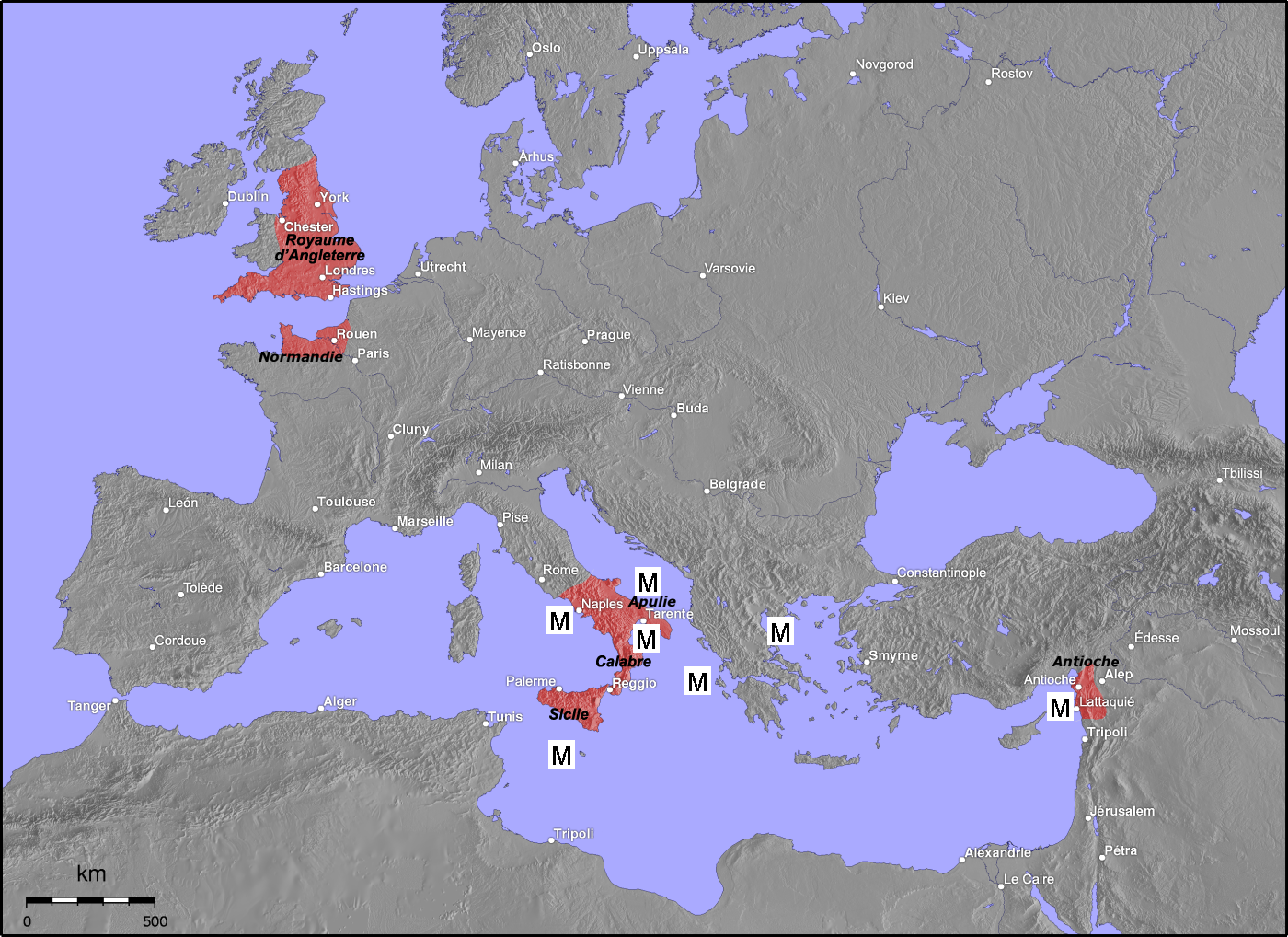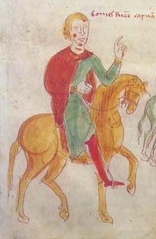|
Tancred, King Of Sicily
Tancred ( it, Tancredi; 113820 February 1194) was King of Sicily from 1189 to 1194. He was born in Lecce an illegitimate son of Roger III, Duke of Apulia (the eldest son of King Roger II) by his mistress Emma, a daughter of Achard II, Count of Lecce. He inherited the title "Count of Lecce" from his grandfather and is consequently often referred to as Tancred of Lecce. Due to his short stature and unhandsome visage, he was mocked by his critics as "The Monkey King". Early career After the death of Duke Roger, to prevent any future trouble, King Roger II kept Tancred and his younger brother William in close custody in Palermo. On 9 March 1161, Tancred joined his uncle Simon, Prince of Taranto, in invading the palace, detained the king and queen, William I and Margaret, and their two sons, and incited a massacre of Muslims. Originally, the older of these two sons, Roger IV, Duke of Apulia, was destined to be crowned in place of William, but soon the populace supported the a ... [...More Info...] [...Related Items...] OR: [Wikipedia] [Google] [Baidu] |
King Of Sicily
The monarchs of Sicily ruled from the establishment of the County of Sicily in 1071 until the "perfect fusion" in the Kingdom of the Two Sicilies in 1816. The origins of the Sicilian monarchy lie in the Norman conquest of southern Italy which occurred between the 11th and 12th century. Sicily, which was ruled as an Islamic emirate for at least two centuries, was invaded in 1071 by Norman House of Hauteville, who conquered Palermo and established a feudal county. The House of Hauteville completed their conquest of Sicily in 1091. In 1130, the County of Sicily and the County of Apulia, ruled by different branches of the House of Hauteville, merged as the Kingdom of Sicily, and Count Roger II was crowned king by Antipope Anacletus II. In 1282, after the Sicilian Vespers, the kingdom split into separate states: the properly named "Ultra Sicily" (''Siciliae ultra Pharum'', Latin for "Sicily over the Strait") and "Hither Sicily" (''Siciliae citra'', commonly called "the Kin ... [...More Info...] [...Related Items...] OR: [Wikipedia] [Google] [Baidu] |
Simon, Prince Of Taranto
Simon, bastard son of Roger II of Sicily, was declared Prince of Taranto by his father in 1148, on the death of Roger III, Duke of Apulia, the eldest legitimate son of Roger II. In 1154, Roger II died and the kingdom of Sicily passed to his fourth son, William I. William dispossessed his half-brother Simon immediately, claiming that Taranto was too important a fief to go to an illegitimate son. Simon held a grudge against the king and was called upon by Matthew Bonnellus to lead the revolt in the capital city of Palermo in 1161. This Simon did, with his nephew, Tancred of Lecce, the bastard son of Roger of Apulia, on 9 March. Simon and Tancred invaded the palace, detained King William, Queen Margaret, and their two sons, and incited a massacre of Muslims. Originally, the older of the king's sons, Roger IV, Duke of Apulia, was destined to be crowned in place of William, but soon the populace supported the accession of Simon himself. Before Simon could put himself forward as a ca ... [...More Info...] [...Related Items...] OR: [Wikipedia] [Google] [Baidu] |
Isaac Komnenos Of Cyprus
Isaac Doukas Komnenos (or Ducas Comnenus, c. 1155 – 1195/1196) was a claimant to the Byzantine Empire and the ruler of Cyprus from 1184 to 1191. Contemporary sources commonly refer to him as the emperor of Cyprus. He lost the island to King Richard I of England during the Third Crusade. Family At the death of Byzantine emperor John II Komnenos in 1143, the throne passed not to his third and oldest living son, Isaac Komnenos, but his youngest son, Manuel I Komnenos, who successfully claimed the throne. Isaac nevertheless served amiably as ''sebastokrator'', and his first wife Theodora Kamaterina (d. 1144) bore him a daughter, Irene Komnene, and other children. Irene Komnene married an unnamed Doukas Kamateros and gave birth to Isaac Komnenos, a minor member of the Komnenos family, . Life Byzantine historian Niketas Choniates provides most of the following account of his life. Isaac was the son of an unnamed member of the noble Byzantine family, Doukas Kamateros, and Irene ... [...More Info...] [...Related Items...] OR: [Wikipedia] [Google] [Baidu] |
Margaritus Of Brindisi
Margaritus of Brindisi (also Margarito; Italian ''Margaritone'' or Greek ''Megareites'' or ''Margaritoni'' ť╬▒¤ü╬│╬▒¤ü╬╣¤ä¤Ä╬Ż╬Ě c. 1149 – 1197), called "the new Neptune", was the last great '' ammiratus ammiratorum'' (Grand Admiral) of Sicily. Following in the footsteps of Christodulus, George of Antioch, and Maio of Bari, Margaritus led the fleets of the kingdom in the reigns of William II (1166–1189) and Tancred (1189–1194). He probably began as a Greek pirate and gradually rose to the rank of privateer before becoming a permanent admiral of the navy. In 1185, he became the first count palatine of Cephalonia and Zakynthos (or Zante). In 1192, he became the first count of Malta. He also held the titles of Prince of Taranto and Duke of Durazzo. Biography Margaritus first appears as a leader of the fleet alongside Tancred, then just count of Lecce, which took Cephalonia and the Ionian Islands in 1185 and then harassed the fleet of Isaac II Angelos at Cypru ... [...More Info...] [...Related Items...] OR: [Wikipedia] [Google] [Baidu] |
Isaac II
Isaac II Angelos or Angelus ( grc-gre, ß╝ޤâ╬▒╬Č╬║╬╣╬┐¤é ╬Ü╬┐╬╝╬Ż╬Ě╬Ż¤î¤é ß╝î╬│╬│╬Á╬╗╬┐¤é, ; September 1156 ÔÇô January 1204) was Byzantine Emperor from 1185 to 1195, and again from 1203 to 1204. His father Andronikos Doukas Angelos was a military leader in Asia Minor (c. 1122 ÔÇô aft. 1185) who married Euphrosyne Kastamonitissa (c. 1125 ÔÇô aft. 1195). Andronikos Doukas Angelos was the son of Constantine Angelos and Theodora Komnene (b. 15 January 1096/1097), the youngest daughter of Emperor Alexios I Komnenos and Irene Doukaina. Thus Isaac was a member of the extended imperial clan of the Komnenoi. Rising by revolt Niketas Choniates described Isaac's physical appearance: "He had a ruddy complexion and red hair, was of average height and robust in body". During the brief reign of Andronikos I Komnenos, Isaac was involved (alongside his father and brothers) in the revolt of Nicaea and Prousa. Atypically, the Emperor did not punish him for this disloyalty, a ... [...More Info...] [...Related Items...] OR: [Wikipedia] [Google] [Baidu] |
Richard, Count Of Acerra
Richard, count of Acerra (died 30 November 1196) was an Italo-Norman nobleman, grandson of Robert of Medania, a Frenchman of Anjou. Brother of Sibylla, queen of Tancred of Sicily, Richard was the chief peninsular supporter of his brother-in-law during his claim for the throne in 1189. Biography Richard was the co-commander of the army attached to Tancred's fleet in 1185. They captured Durazzo from the Byzantine Empire without a struggle. The city had fully surrendered by June 24. Richard then led his army on a march across the Balkan peninsula and by August 6 he had begun his Siege of Thessalonica. On August 24 Thessalonika fell to Richard's armies in its turn. But Richard was defeated and captured at Battle of Demetritzes. In 1190, Richard was charged with keeping the German supporters of Roger of Andria out of Apulia. Richard secured all Apulia and the Terra di Lavoro. Richard then "raised a great army of Romans and men from Campania and the '' Regno'' to attack ... [...More Info...] [...Related Items...] OR: [Wikipedia] [Google] [Baidu] |
Constance Of Sicily
Constance I ( it, Costanza; 2 November 1154 ÔÇô 27 November 1198) was reigning Queen of Sicily from 1194–98, jointly with her spouse from 1194 to 1197, and with her infant son Frederick II, Holy Roman Emperor, in 1198, as the heiress of the Norman kings of Sicily. She was also Holy Roman Empress and later Dowager by marriage to Henry VI, Holy Roman Emperor. When she was young, as the sole heir to the throne of Sicily, she didn't marry until she was 30 because of an ominous prophecy; shortly after becoming empress she was involved in the succession war against her illegitimate nephew King Tancred of Sicily for the Sicilian throne, during which, rarely for an empress, she was captured during such an offensive campaign, though finally without danger she escaped. In the history of Holy Roman Empire only two empresses had ever been captured, the other being her mother-in-law Empress Beatrice. Shortly before ascending the Sicilian throne, at the advanced age of 40, she gave b ... [...More Info...] [...Related Items...] OR: [Wikipedia] [Google] [Baidu] |
Steven Runciman
Sir James Cochran Stevenson Runciman ( ÔÇô ), known as Steven Runciman, was an English historian best known for his three-volume '' A History of the Crusades'' (1951ÔÇô54). He was a strong admirer of the Byzantine Empire. His history's negative portrayal of crusaders and contrasting more favourable view of Byzantine and Muslim societies had a profound impact on the popular conception of the Crusades. Biography Born in Northumberland, he was the second son of Walter and Hilda Runciman. His parents were members of the Liberal Party and the first married couple to sit simultaneously in Parliament. His father was created Viscount Runciman of Doxford in 1937. His paternal grandfather, Walter Runciman, 1st Baron Runciman, was a shipping magnate. He was named after his maternal grandfather, James Cochran Stevenson, the MP for South Shields. Eton and Cambridge It is said that he was reading Latin and Greek by the age of five. In the course of his long life he would master an aston ... [...More Info...] [...Related Items...] OR: [Wikipedia] [Google] [Baidu] |
Saladin
Yusuf ibn Ayyub ibn Shadi () ( ÔÇô 4 March 1193), commonly known by the epithet Saladin,, ; ku, ě│┘çÔÇî┘äěžěş┘çÔÇîě»█î┘ć, ; was the founder of the Ayyubid dynasty. Hailing from an ethnic Kurdish family, he was the first of both Egypt and Syria. An important figure of the Third Crusade, he spearheaded the Muslim military effort against the Crusader states in the Levant. At the height of his power, Ayyubid territorial control spanned Egypt, Syria, Upper Mesopotamia, the Hejaz, Yemen, the Maghreb, and Nubia. Alongside his uncle Shirkuh, a military general of the Zengid dynasty, Saladin was sent to Egypt under the Fatimid Caliphate in 1164, on the orders of Nur ad-Din. With their original purpose being to help restore Shawar as the to the teenage Fatimid caliph al-Adid, a power struggle ensued between Shirkuh and Shawar after the latter was reinstated. Saladin, meanwhile, climbed the ranks of the Fatimid government by virtue of his military successes against Crusa ... [...More Info...] [...Related Items...] OR: [Wikipedia] [Google] [Baidu] |
Amalric I Of Jerusalem
Amalric or Amaury I ( la, Amalricus; french: Amaury; 113611 July 1174) was King of Jerusalem from 1163, and Count of Jaffa and Ascalon before his accession. He was the second son of Melisende and Fulk of Jerusalem, and succeeded his older brother Baldwin III. During his reign, Jerusalem became more closely allied with the Byzantine Empire, and the two states launched an unsuccessful invasion of Egypt. He was the father of three future rulers of Jerusalem, Sibylla, Baldwin IV, and Isabella I. Older scholarship mistook the two names Amalric and Aimery as variant spellings of the same name, so these historians erroneously added numbers, making Amalric to be Amalric I (1163ÔÇô74) and King Aimery (1197ÔÇô1205) to be "Amalric II". Now scholars recognize that the two names were not the same and no longer add the number for either king. Confusion between the two names was common even among contemporaries. Youth Amalric was born in 1136 to King Fulk, the former count of Anjo ... [...More Info...] [...Related Items...] OR: [Wikipedia] [Google] [Baidu] |
Alexandria
Alexandria ( or ; ar, ┘▒┘ä┘ĺěą┘Éě│┘ĺ┘â┘Ä┘ć┘ĺě»┘Äě▒┘É┘Ő┘Ä┘Ĺěę┘Ć ; grc-gre, ╬Ĺ╬╗╬Á╬ż╬Č╬Ż╬┤¤ü╬Á╬╣╬▒, Alex├índria) is the second largest city in Egypt, and the largest city on the Mediterranean coast. Founded in by Alexander the Great, Alexandria grew rapidly and became a major centre of Hellenic civilisation, eventually replacing Memphis, in present-day Greater Cairo, as Egypt's capital. During the Hellenistic period, it was home to the Lighthouse of Alexandria, which ranked among the Seven Wonders of the Ancient World, as well as the storied Library of Alexandria. Today, the library is reincarnated in the disc-shaped, ultramodern Bibliotheca Alexandrina. Its 15th-century seafront Qaitbay Citadel is now a museum. Called the "Bride of the Mediterranean" by locals, Alexandria is a popular tourist destination and an important industrial centre due to its natural gas and oil pipelines from Suez. The city extends about along the northern coast of Egypt, and is the large ... [...More Info...] [...Related Items...] OR: [Wikipedia] [Google] [Baidu] |
Constantinople
la, Constantinopolis ota, ┘éě│ěĚ┘ćěĚ┘Ő┘ć┘Ő┘ç , alternate_name = Byzantion (earlier Greek name), Nova Roma ("New Rome"), Miklagard/Miklagarth ( Old Norse), Tsargrad ( Slavic), Qustantiniya (Arabic), Basileuousa ("Queen of Cities"), Megalopolis ("the Great City"), ╬á¤î╬╗╬╣¤é ("the City"), Kostantiniyye or Konstantinopolis (Turkish) , image = Byzantine Constantinople-en.png , alt = , caption = Map of Constantinople in the Byzantine period, corresponding to the modern-day Fatih district of Istanbul , map_type = Istanbul#Turkey Marmara#Turkey , map_alt = A map of Byzantine Istanbul. , map_size = 275 , map_caption = Constantinople was founded on the former site of the Greek colony of Byzantion, which today is known as Istanbul in Turkey. , coordinates = , location = Fatih, ─░stanbul, Turkey , region = Marmara Region , type = Imperial city , part_of = , length = , width ... [...More Info...] [...Related Items...] OR: [Wikipedia] [Google] [Baidu] |
_at_Cyprus.jpg)






.jpg)
